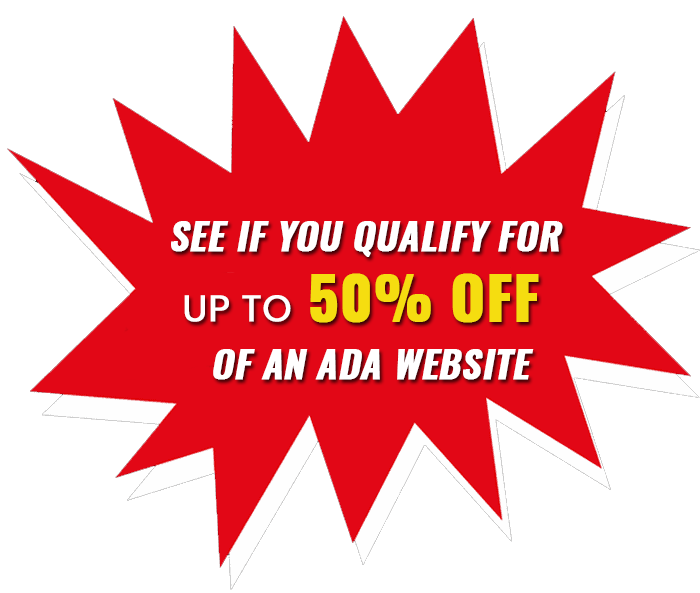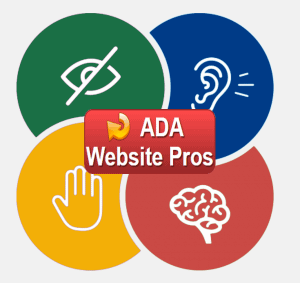ADA Compliant Website Accessibility in Seaside California
Ideally, everyone should be able to use any website on the internet. It shouldn’t matter if they have a condition that affects their capabilities or what hardware and software they need to use. This is the main tenet behind the concept of web accessibility.

A Brief Introduction to Web Accessibility
The fact is that millions of internet users have special needs and impairments that can make it difficult or even impossible for them to use certain types of websites. By designing your site with these challenges in mind, you can ensure that it’s welcoming to as many users as possible.
While there are a lot of disabilities and conditions that can affect the way people use websites, let’s take a look at some of the most common categories of impairments:
Vision
This includes a partial or total inability to see or to perceive color contrasts.
Hearing
Some users have a reduced ability to hear.
Motor Skills
These are people with difficulty moving parts of their bodies, including making precise movements (such as when using a mouse).
Photosensitive Seizures
Conditions such as epilepsy can cause seizures that are often triggered by flashing lights.
Cognitive Disabilities
There are also many conditions that affect cognitive ability, such as dementia and dyslexia.
10 Ways to Make Your Website Accessible

1. Make Sure Your Site Is Keyboard-Friendly
This step is also the most important. Put simply: for a website to be accessible, it must work without the use of a mouse. This is because many assistive technologies rely on keyboard-only navigation. As such, it must be possible to use all of your site’s major features via a keyboard and nothing else. This includes accessing all pages, links, content, and so on.
2. Make Sure All Content Is Easily Accessible
In addition to making your site keyboard-friendly, you also need to ensure that all content on the page is actually accessible. While this is usually not a problem, it can be an issue when a page contains dynamic content.
3. Add Alt Text to All Images
Alt text (sometimes called alt attributes, alt descriptions, or alt tags) is also accessed by screen readers to ‘read’ the picture. You can therefore use this field to describe an image, giving context to users who would otherwise miss it.
4. Choose Your Colors Carefully
9% of men have some form of colorblindness. We should think about this when designing a site!
5. Use Headers to Structure Your Content Correctly
Another key task to make your site accessible is structuring your content by using headers carefully. Doing this will make your content much easier to understand and digest and improves flow.
6. Design Your Forms for Accessibility
Forms are a useful addition to most sites but must be designed carefully. What’s most important is to ensure that each field is clearly labeled. You should also aim to place the labels adjacent to the respective fields. While a sighted user can easily match a label to the corresponding field or option, this may not be obvious for someone using a screen reader.
7. Don’t Use Tables for Anything Except Tabular Data
When it comes to displaying data, tables are handy. They make it much easier for all users, including those using assistive technology, to parse a large amount of data. To get the maximum benefit, however, you’ll want to keep your tables as simple as you can.
8. Enable Resizable Text That Doesn’t Break Your Site
Most devices and browsers will enable users to resize text, which can be helpful for those with visual impairments. However, if you don’t build your site to support this feature, resizing text could break your design or make it difficult to interact with your site.
9. Avoid Automatic Media and Navigation
Automatically-playing media files have been a bane of internet users since the days of MySpace. As annoying as it can be to have music or videos start when a page loads, this is an even bigger issue in terms of accessibility.
10. Create Content With Accessibility in Mind
Finally, we come to the core of your site: its content. While designing your site for accessibility is hugely important, you should bear the same considerations in mind when creating content.


Websites For All
Making sure your site is welcoming to as many people as possible should be a top priority. There’s no reason to exclude anybody, especially since it’s relatively easy to avoid doing so. Not only will your users thank you, but you’ll also likely see benefits in the form of increased traffic and conversions.
By taking the time to understand the possible flaws in your design and content, you can make sure your site is optimized for accessibility today.
Seaside, California
Nearby Cities:

Website Questionnaire
-
Cristian Sanchez v. Blockfi Inc.
Plaintiff Name: Cristian Sanchez Filing date: April 29, 2021 State of filing: New York Defendant Name: Blockfi Inc. Website: www.blockfi.com Industry: Software & Services Summary: Crypto asset service. Case Summary On April 29, 2021, Cristian Sanchez filed a complaint in New York against Blockfi Inc.. Plaintiff Cristian Sanchez alleges that www.blockfi.com is not sufficiently digitally…
-
Cristian Sanchez v. FETCH! PET CARE, INC.
Plaintiff Name: Cristian Sanchez Filing date: April 29, 2021 State of filing: New York Defendant Name: FETCH! PET CARE, INC. Website: www.fetchpetcare.com Industry: Diversified Consumer Services Summary: Provides loving and convenient pet care. Case Summary On April 29, 2021, Cristian Sanchez filed a complaint in New York against FETCH! PET CARE, INC.. Plaintiff Cristian Sanchez…
-
BRIAN FISCHLER v. MAGIC SPOON INC.
Plaintiff Name: BRIAN FISCHLER Filing date: April 30, 2021 State of filing: New York Defendant Name: MAGIC SPOON INC. Website: www.magicspoon.com Industry: Food, Beverage & Tobacco Summary: Magic Spoon cereal is high-protein, low-sugar, keto-friendly, and gluten-free. Available in Cocoa, Frosted, Fruity, Blueberry, Peanut Butter, and Cinnamon. Case Summary On April 30, 2021, BRIAN FISCHLER filed…